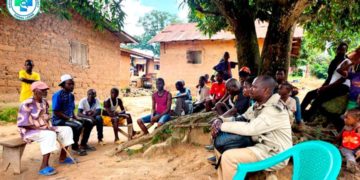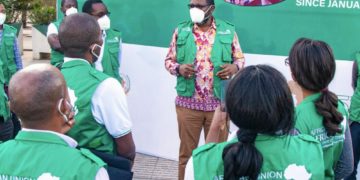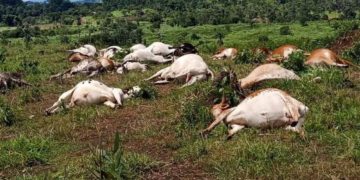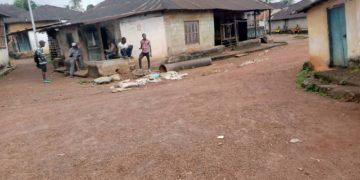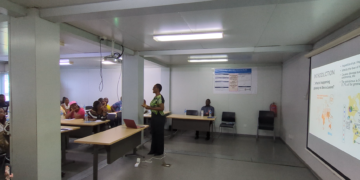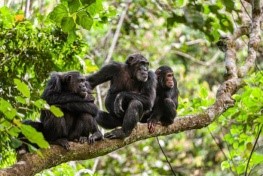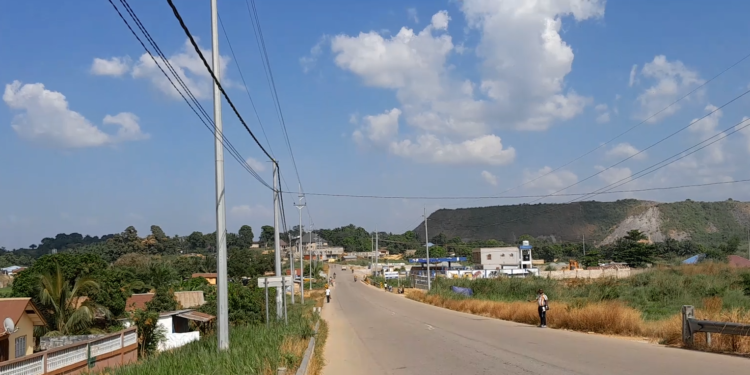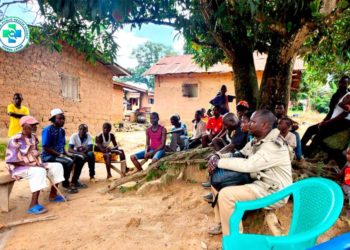By Kemo Cham
From his backyard, the view of the main plant of diamond miner Meya, serves as a perpetual unpleasant reminder to Tamba Ansumana Nyanga of the tribulations of his community.
“We live in constant fear,” Mr Nyanga told ManoReporters in an interview outside his veranda, overlooking the artificial mountain lining the skyline of Koidu, the headquarters town of Sierra Leone’s diamond rich eastern Kono District.
Meya Mining secured a large-scale mining licence in Sierra Leone in 2019, two years after it began exploration for the minerals. Partly owned by Namibian registered Trustco Resources, Meya’s 130.38 km² kimberlite concession spans four chiefdoms – Nimikoro, Kamara, Gbense and Tankoro – and it is one of the top three largest diamond miners in the country.
Sierra Leone is rich in diverse mineral resources, notably rutile, bauxite, gold and iron ore. But it is diamonds that it’s most famous for. Over 500 million carats of the gemstones are estimated to have been unearthed in the country since it began exploring them in 1935.
In 2017, Meya discovered a 476-carat stone, ranked as the 29th largest diamond ever discovered in the world. Just a month earlier, an artisanal miner discovered the 709 carat ‘Peace Diamond’ – the world’s 14th largest diamond.
All of those and many other diamonds that have been extracted from Kono and other parts of the country have sold for billions in the international market. And these have come at a huge cost for residents of mining communities like Cemetery Road in Koaquima, where Nyanga lives.
Meya’s plant is located in an area that used to be a swamp, which was the main source of livelihoods for the hundreds of families in the community. Some of them claim they were only given pittance for their land. And on top of that, they now have to deal with a lot of other issues resulting from the company’s operation.
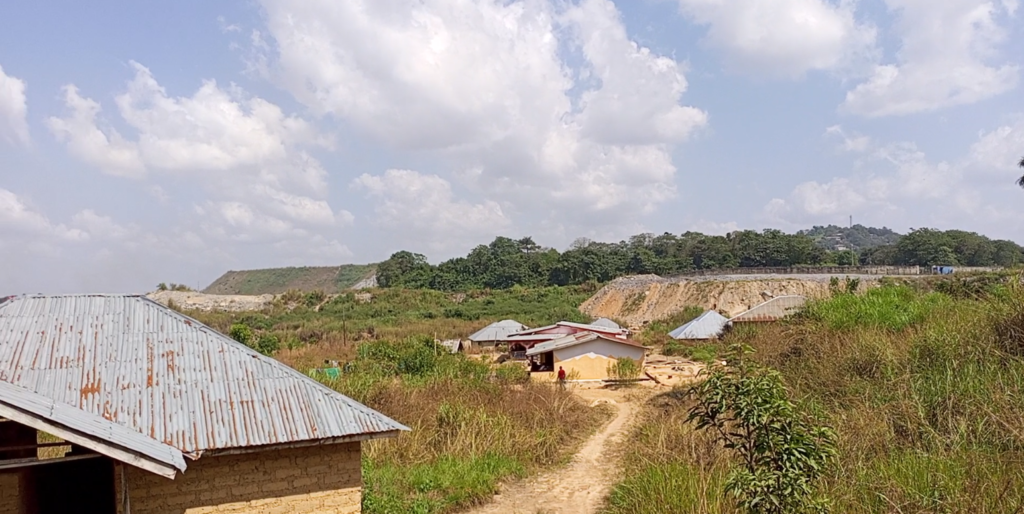
Mr Nyanga is one of the first inhabitants of Cemetery Road. He built his house in 2004.
The experience of the community was the subject of a December 2022 report by Amnesty International, titled: ‘No diamond is worth the life a community.’
Prior to Sierra Leone’s (1991-2002) civil war, mining was the favourite economic activity for most residents of Kono, partly because it didn’t require as much intense activity as it is these days. With the dwindling presence of the precious stones on the surface of the earth, sophisticated machines are now required to extract them from kimberlite rocks, deep in the earth. Blasting with explosives is one of the primary methods employed by large scale miners.
Initially, Meya, like many other companies before it, did open air blasting. The whole community within its operational areas were temporarily relocated to a village square outside the blasting zone, where they waited for at least an hour for the blasting to complete.
This exercise occurred at least two times in a week, according to residents.
“We were forced to leave whatever we were doing when they came to evacuate us,” recalled Mr Nyanga. “It was like a war situation. Even if you were cooking, you had to leave the pot on the fire.”
As its operations advanced, Meya adopted underground mining method, which means the blasting is done underground. But still, residents say their trouble is far from over.
“When they conduct the blasting, the whole ground beneath us shakes. You can feel that everywhere is shaking. Those of us here with children and families, we just bear it, but we are afraid because we have no idea about the future,” he said.
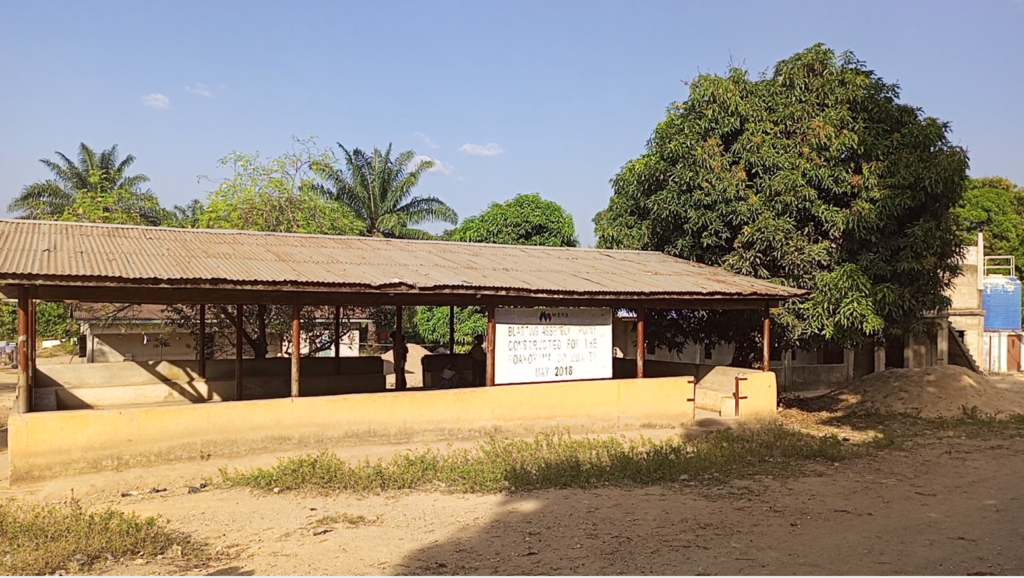
A barray (village square) in Koaquima, where residents were temporarily relocated during open air blasting by miner, when Meya. Photo credit, Kemo Cham, ManoReporters
But the blasting is the least of the concerns of many of the people of Cemetery Road. They say their water sources have all been contaminated due to the company’s activities. This is well captured in the Amnesty report. The watchdog says as part of its investigations conducted between 2018 and 2021, it took water samples for testing from two boreholes constructed by Meya for the community. The results revealed high levels of nitrates in both samples (110 mg/l for the sample 1 and 120 mg/l for the sample 2), which were well above safe levels (50 milligrams per liter) recommended by the World Health Organization. Consumption of high levels of nitrate can be harmful, especially for babies.
According to Amnesty, Meya Mining confirmed that they also tested the water in the boreholes the same year and that they did not contest the high level of nitrate in the water at this time.
Because of this, the community people use their water sources here only for laundering. Getting water for drinking and cooking is an uphill task.
But due to the effect of the blasting, with time, even to get water for bathing or laundering has become a problem. This is because due to the tremor caused by the blasting, the concrete walls of the wells fell into the water, rendering them useless.
Consequently, women and girls have to walk long distance to fetch water for domestic use.
Sidiki Sankoh and his two brothers have just finished taking launch and they have no water to drink, even though within their compound is a water well.
“There is no water in the well to fetch,” said Sidiki, a Grade 7 pupil.
The wells Meya constructed are a long trekking distance for residents of Cemetery Road. And according to Sidiki and his brothers, reaching there is just the beginning of the problem for them.
“Usually, hundreds of people stand on a queue to fetch just a bucket of water. It’s a long wait and it’s very frustrating. Most of the time we go to school without bathing,” he said.
Yayae Norma’s children attend Senior Secondary School in Koidy city, which is about 10 minutes’ bus ride from Kuaquima. The girls have to rush not to miss the school bus, the mother said, noting that this means sometimes they leave without any water in the house.
The blasting also has a toll on buildings. Very few in Cemetery Road are without cracks, which requires regular maintenance, said Nyanga.
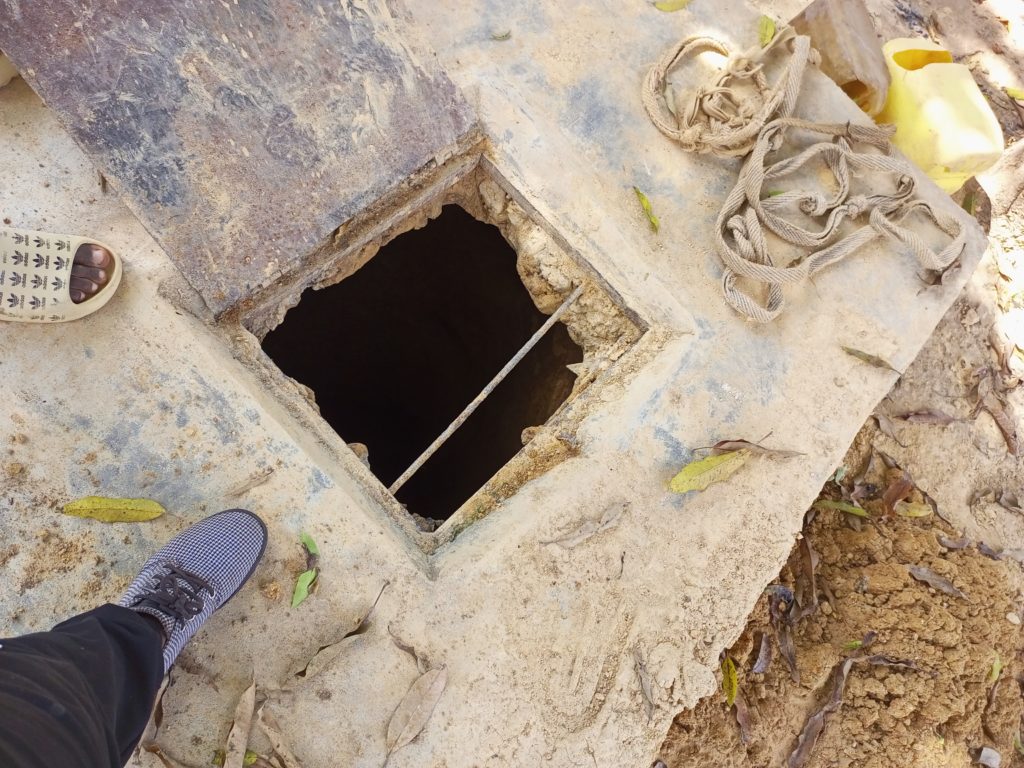
A lot of water wells like this in Cemetery Road have been rendered useless due to constant blasting by Meya Mining Company. Photo credit, Kemo Cham, ManoReporters
Meya Mining didn’t grant our request for response to the concerns raised by the community and Amnesty. The management backtracked at the 11th hour of a scheduled interview with Manoreporters. A spokeswoman said they were advised against talking to the press.
Amnesty International, in its report, urged the Sierra Leone government to ensure that the company has done what it says it has done in terms of implementation of its recommendations.
The National Minerals Agency (NMA), which regulates the operations of mining companies, also declined our request for interview.
After repeated calls and messages that went unanswered, the Director of Communication and Community Affairs only responded with a short text message: “The NMA’s attention has been drawn to the report and the allegations contained therein. We are reviewing the content of the report and will have an official reaction shortly.”
Seventeen months later, the Agency is yet to release any statement on the matter.
Sierra Leone is no stranger to complaints of rights violations around it’s vast mineral wealth. Kono, which is the heart of it’s diamond riches, was an epicenter of the civil war, which was partly fueled by the gems. The concept of blood diamond was coined from the role precious minerals played in fueling conflicts in three countries in the 1990s – Sierra Leone, the Democratic Republic of Congo and Angola.
The Sierra Leone war was the subject of a Hollywood blockbuster of the same name – Blood Diamond – released in 2006.
Because of this, a lot of efforts at international level have been made to ensure minerals generally aren’t used to fuel conflicts, through the so-called Kimberley Process Certification Scheme (KPCS), in the case of diamonds.
In Sierra Leone, successive post-war governments have also undertaken a lot of policy initiatives, including review of the country’s mining laws, geared towards ensuring that its mineral resources are used to benefit the people, especially those who live in mining communities. Despite these efforts, the complaints continue.
Arthur Kargbo, a civil society activist based in Koidu, said all the problems for Kono boil down to lack of communication.
Arthur heads the Advocate for Social Justice and Development (ASJD), an organization that advocates for just mining. He said that failure of authorities and mining companies to operate openly and transparently makes it difficult to address expectations that have translated into violence and threats of violence.
“Kono has provided wealth for this country but it has hardly reflected on the lives of its own people,” the activist said. “And until this issue is addressed, which cannot be done without transparency, accountability and the judicious use of the resources, the complaints will continue.”

Meya is one of three main multinational companies operatingg large scale diamond mining in the district. Adjacent to its plant is that of Koidu Limited, the oldest among them. Koidu Limited, also known as Octea, is also the largest of them, and so is the magnitude of its problems with communities within its concession area. There is also Seawright, an American owned company.
Kono has seen repeated violence and threats of violence sparked by complaints of indigenes of the district who feel exploited by these mainly foreign owned companies.
The district is already one of the least developed and most neglected among Sierra Leone’s 16 districts. Much of its infrastructure destroyed during the war remains in ruins. It has few paved roads and no running water. Electricity is erratic.
The people see the persistent problems emanating from the activities of mining companies as indication of continued government neglect of their plight, hence the recurrent outbreak of violence.
The mining companies often emphasize their role as providers of employment. But locals say only casual and less lucrative jobs are reserved for them. Even at that, they constantly complain of poor working condition.
Between 2007 and 2016, at least four violent protests erupted in the district, some with fatal consequences.
In the 2007 incident, nine people were reportedly shot by police. While the protesters claimed four of their colleagues were killed by the police, the latter insisted that only two people died in the violence. There was also disagreement over who pulled the trigger, between the security forces and protesters.
Five years later, in 2012, foreign staff of Koidu Holdings were holed up at the mine amid a violent strike by local workers aggrieved over poor working condition and alleged racial discrimination. At least two people lost their lives in that incident.
More recently, there have been several cases filed in courts seeking to force mining companies to respect the human rights of communities within their operational areas.
The concerns always arise from operational expansions, which have led to widespread destruction of the city and its surrounding, and the eviction of hundreds of people from their homes. It also caused major disruption to local livelihoods, destroying swaths of farmlands, polluting the air and contaminating underground water in the area.
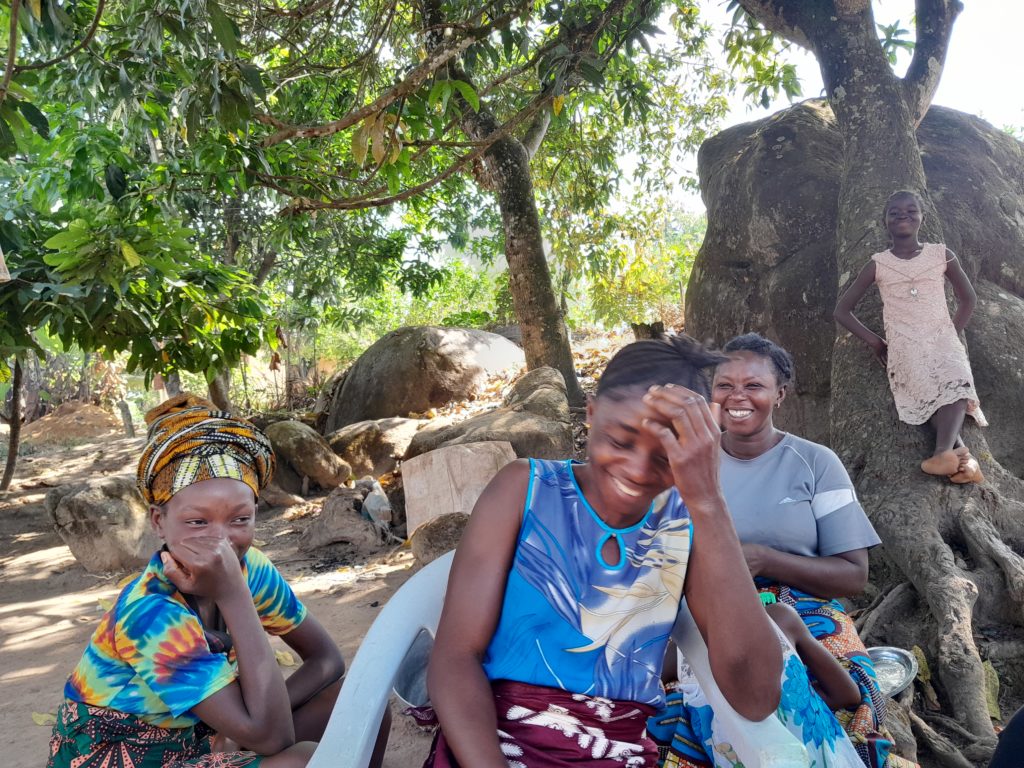
Yayae Norma and her children trek long distance t fetch water for domestic use. She is disappointed that despite promises made by Meya Mining, her husband hasn’t been able to secure a job at the miner. Photo credit, Kemo Cham, ManoReporters
Aside from the provision of inadequate substitute housing to the evicted residents, affected communities say they have not received compensation for damages.
Koidu has few paved roads, compared to other districts, and no running water. Electricity is erratic.
Affected landowners who often protest mining expansion say they are intimidated by security forces on the orders of the miners.
Recent threats of protests by an organization representing natives of Kono in the diaspora, showed that the prospect for conflict still exists. The group called for a global demonstration in 2016, in protest against the international diamond retailer Tiffany & Co.’s financial partnership with Octea Group – the sole owner of Koidu Holdings Ltd, for its alleged gross injustice against the people of Kono. It followed a ruling by the Sierra Leone high court determining that Octea was not entitled to pay taxes because the parent company was not legally registered to do business in the country.
Both Meya and Koidu Limited shared parts of Tankoro Chiefdom, believed to be the most endowed among all the chiefdoms in the district. Paramount Chief Paul Gaber Saquee IV of Tankoro, has come under constant scrutiny to justify the continued operation of the companies. The Chief withdrew from an initial commitment to talk to ManoReporters when contacted for a response.

